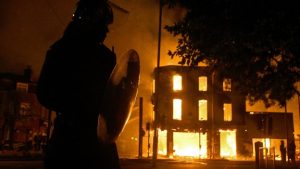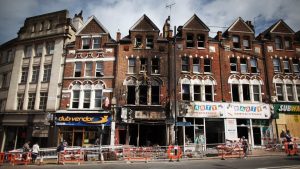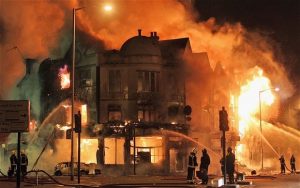The London Riots Ten Years On - a study in Crisis Management
Ten Years On, The London Riots

Ten years ago saw the beginning of a dark, difficult but mercifully short period in London’s history with civil unrest on the streets of London. I still have vivid memories of the events and my involvement in them.
I had attended riots and civil unrest as a firefighter in 1985 in Brixton. Trying to put out fires whilst people were throwing bricks, bottles and anything else they could find at us was an experience I hoped I’d never undergo again. It felt as if the public had turned against us.
However the experience and learning from that period was to stand me in good stead 26 years later.
In 2011 it all started in Tottenham on Saturday 6th August following the fatal shooting of a man the day before by armed police in Tottenham. The mood in the area grew steadily worse until on the Saturday night it descended into ugly scenes with numerous fires started over an area about a mile long. I was off duty that weekend but was alerted to it and kept a watching brief via both television and via my Fire Service personal radio. The fires raged well into Sunday morning.
Sunday daytime was relatively peaceful until disorder again broke out that evening in Tottenham and also in Brixton in South West London.
Monday dawned and I was back at work and spent most of the day in meetings and making phone calls to colleagues in the other emergency services trying to get my situational awareness up as well as gather intelligence about the likelihood of further unrest. This was part of my remit as Head of Special Operations Group in London Fire Brigade and I had very good working relationships with Met Police, London Ambulance Service and Local Authority colleagues in London as well as with colleagues in government departments; Department for Communities and Local Government, Home Office, Department of Health and Cabinet Office. The feeling was that the civil unrest/rioting was likely to continue.
I had an excellent team around me and between us we made sure that we were fully apprised of the situation and were well prepared to deal with further unrest if it arose. By late afternoon/ early evening that day, unrest and rioting had broken out in Hackney and Peckham (East and South East London respectively).
A couple of Fire Service colleagues had had their cars damaged by rioters throwing things at them when they arrived on scene – neither was hurt but it served as a reminder to everyone about the dangers ahead.
I went home that evening and grabbed some dinner whilst watching events unfolding on tv, I was now in constant contact with my team and other emergency services colleagues and knew that it was going to be a very difficult evening.
I knew what the priorities were – public and responder safety, prevent fire spread and assist in a return to normality – and in just about every phone call I had, I either verbally or mentally ticked each of these off. These priorities were framework for decision making.
I was watching the scenes unfolding in Croydon as my pager went off, I was being ordered to take charge of a large fire in a furniture store at Reeves Corner in Croydon. I contacted the London Fire Brigade control room, got a brief about the incident and asked for all the other officers attending to meet me at the nearby fire station before going to the incident. I was acutely aware that we would all be travelling alone and I wanted to get everyone to a safe place for a quick brief before travelling together to the actual scene. I also decided to change out of my fire service uniform (white shirt and black trousers very similar to the police) and into a tee-shirt and jeans and carry my Fire Service ID card.
On my way to the fire station rendezvous point, I was stopped by an armed police officer who told me to make a detour as there was potentially an armed suspect in the locality I was driving through. Although this particular incident was thought to be nothing to do with the riots, it only served to heighten my awareness of the threat that we might face.
I met up with my command team and we all travelled in my car the last mile or so to the incident. We arrived at the scene - there was a very serious fire in progress the air was thick with smoke and fumes and the firefighters were all working hard . As incident commander I was focused on just two priorities – safety of public and responders and preventing further fire spread. The initial crews had performed magnificently, rescuing a number of people from nearby properties and searching others to make sure that no-one was left in any danger. Nearby buildings were catching fire due to radiated heat so water jets and sprays were used to protect these – we knew that the place where the fire started was lost as it had got too much of a hold – pretty much the whole building was alight. By normal standards the incident was under resourced, just eight pumps when we needed double that amount and because we had no Command Unit ( a mobile hub with communications equipment and the ability to map out the scene for situational awareness) I had to command using very basic methods – my senses, my personal radio and my pointing finger. It was quite liberating in a strange sort of way.
The police did a good job of protecting us to let us get on with our work – I had a public order cop (trained in dealing with riots and civil unrest and wearing specialist protective equipment, carrying a riot shield) with me initially and he kept me informed about the police view of things. Just as we were starting to make headway with the firefighting, the cop informed me that he had to withdraw the public order team protecting us as they were needed elsewhere in Croydon. It seems that the rioters were using mobile phones to communicate with each other and moving around in small gangs to loot shops and start fires before moving on to another location.
The cop managed to get some police officers to protect us but those police had little protection themselves. I decided to move the fire appliances to park across all the access roads to the scene so that we had some physical safety in place to protect the responders.
At one part a group of around ten to fifteen people all wearing masks or covering their faces – some carrying lumps of wood – stood watching us. They moved on following a conversation with the police.
I was also in constant communication with the Gold Command Team (the executive team) from London Fire Brigade who were giving me a London wide overview of incidents and resources. I was aware that a significant fire was in progress at a Sony Warehouse in Enfield and that the unrest was spreading very quickly to other parts of London.
By now, my mobile phone was in meltdown – I had already recharged it once and I now had to use my spare battery – I had learned from previous experience that these are the little things that can catch you out in a crisis.
I needed my communications but I simply couldn’t service all the calls I was receiving so I prioritised them and only made and received calls when necessary.
As we were starting to get the fires under control, I was introduced to Trevor Reeves - his family owned the store and it had been a family business since 1867. I will never forget him; despite the obvious shock and trauma of seeing his store burned to the ground he wanted to thank the firefighters for what they had done which was incredibly thoughtful of him. I was able to show him that we had saved a second store owned by his family very close by - it had sustained some heat damage to the outside but we had stopped the fire from spreading to the inside. He managed to reopen this store around three to four weeks later.
Once all the public had been rescued/evacuated and the fires were no longer likely to spread, I downgraded the incident, handed it over to another officer and left.
Almost immediately I was ordered to attend another large fire, this time in Clapham. I didn’t use my blue light and two tone horns until well away from any unrest so nobody noticed a guy in a tee shirt and jeans driving through Croydon and I was untroubled.
Despite everything that was happening the areas outside the rioting were very quiet and I was able to switch on my twos and blues and make good progress – turning them off again once I was within half a mile of the scene.
The first thing I noticed when I arrived at Clapham Junction was the debris strewn over the street – mobile phone boxes, shoe boxes, trainers and clothes mostly.
The fire was in some four storey buildings – shops on the ground floor with flats above – and it was raging. Firefighters were again undertaking rescues and evacuating the public and there was some water from an aerial appliance (a cherry picker if you like) preventing fire spread at roof level and to one side with water jets on the other side trying to prevent any further lateral spread.
This time I did have a Command Unit on site so I ran the incident from there ably supported by an excellent command team and outstanding firefighters - again they all went the extra mile physically working incredibly hard to get the blaze under control.
Once again the resources were well below the number we would usually have had for this incident had it occurred during normal circumstances. The firefighters made great progress with the search and rescue of people in the flats above the shops however the fire was still spreading to other shops and flats. I was contacted by the Gold Command Team and asked to release some firefighters and fire appliances as London Fire Brigade resources were beginning to get stretched.
I was concerned that the situation at my incident was not yet under control so I asked for a grace period of an hour so that I could alter the plan and then release some crews which was granted. My command team worked with me to produce a new plan which we put into place and duly released the resources.
Once again, liaison with the police on scene was excellent and they were able to give us a safe area within which to do our job. The rioting in Clapham was not as extensive as it was in Croydon so there were more police available to protect us. We held very brief multi-agency meetings with police and ambulance crews every hour or so covering off those three strategic priorities and assessing what resources we needed over the coming hour.

Once we had confirmed that all the people in the flats were safe and the fire was under control, I again downgraded the incident handed over command and left only to be ordered back to Croydon again.
This time we had a whole row of shops and flats alight and it was clear that the fire had taken a complete hold on the entire block, fortunately all the people were safe.
One fire appliance had been attacked and had sustained damage and one firefighter had sustained minor injuries – this did not deter the crews at all and they continued in their efforts to prevent the fire from spreading further.

By now the firefighters and officers were very weary and although all the firefighting took place from outside the building (I was worried about the building collapsing and we couldn’t get any building surveyors out until later that morning) I was really concerned that an accident or an injury could occur as all the firefighters had been working hard for a very extended period. Some local shopkeepers and residents had kindly provided the crews with some water and food (we usually had the Salvation Army canteen van on site at big incidents but for obvious reasons, that was not an option) so they were able to take short breaks and take on fluid but that was not enough, they needed rest.
So, back to the priorities, my first job was to get some relief crews and officers in, though of course no-one on duty that night had had any real rest.
Once the relief crews were in place and the external firefighting plan was actioned, it was finally a chance for me to catch my breath and I suddenly realised how tired I was (it was around 7 am on Tuesday morning by now I had been awake and working since 6 am the previous day).
I decided to request a relief for myself to arrive after the new shift had started at 8 am, having done this I was then approached by a BBC Breakfast news reporter asking for a live interview.
I decided to do it and I think it went well – my main message was that the emergency services in London work well together and had well-rehearsed plans for these types of event/incident. Unfortunately, I forgot that I hadn’t shaved in over 24 hours so I looked a bit unkempt but I hope that that did not detract from the message.
I went home and got a few hours sleep before being called to a multi-agency strategic meeting to discuss the clean up operation and return to normality. It was great to see that residents and shop owners in Clapham Junction had gone about the job themselves and had helped to clean and board up the area.
Sadly, the unrest spread to other parts of the UK though thankfully it had petered out by the end of the week. The criminal justice system and the police worked really hard to bring the perpetrators to justice very quickly and I suspect that that prevented further outbreaks along with some great work by community leaders.
That night, over ten years ago saw the very best and the very worst of human nature and it will be forever etched on my memory along with the pride that I still feel for being able to work with such dedicated, professional people.

